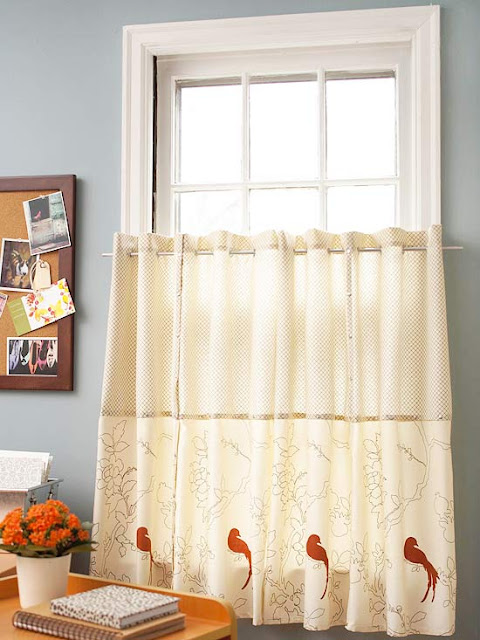Do-it-yourself curtains and drapes are easier to make than you might think. With a little bit of fabric, a staple gun and some creativity, you can fashion an interesting look for your home.
These projects can all be done without making a single stitch.
These projects can all be done without making a single stitch.
Napkin Cafe Curtains
Turn patterned cloth napkins into a kicky pair of curtains by joining their edges with jeans rivets spaced every 2 inches. Then add large grommets or rivets along the tops of the panels and thread onto a curtain rod. You can buy rivet and grommet kits at fabric stores. To install, cut a small hole in the fabric, insert both pieces of the rivet or grommet, and use the tool that comes in the kit to press them together.
Towel Window Treatment
Use kicky kitchen dish towels for fun window treatments. Simply clip drapery hooks to the top edge of a dishtowel and hang from a cafe curtain rod. The towels are easy to remove for washing and can also be changed out seasonally. Plus, when you've decided to move on to a different window treatment, the towels can be used for their original purpose of drying dishes.
Buttoned Up
The buttons and burlap that jazz up these plain white tab-top cafe curtains come right off when it's time to wash them. That's because the buttons are attached with magnets rather than sewn on. Tie hemp cord through each button, then glue a magnet onto the back. Cut burlap into a strip 1-1/2 inches wide and pull off a few of the long threads to fringe the edge. Lay the burlap on top of the curtain and hold it in place with a magnetic button at each tab.
Trimmed Tablecloths
Romance a window with a pretty curtain made from a tablecloth. Look for a square or rectangular one with tassels, ruffles, or scallops they'll add instant detail that you don't have to sew on. Cut the tablecloth into two panels. (A 60-inch square cloth is handy because you can just cut it in half.) Hem the cut edges with iron-on seam tape, and hang with drapery clips.
Wrapped Windows
Made from shawls found for $8 each, these panels are an inexpensive alternative to custom window treatments. Cut away the fringe from one end of each shawl and hot-glue decorative trim along the raw end. Hang from clip rings.
Floor-Length Tab-Top Panels
Velvet ribbon in three sherbet shades turns plain white tab-top curtains into an elegant treatment. To create the look, lay out the panels and attach horizontal bands of ribbon with fabric glue. To make the ties at the top, cut the tabs off, then cut six evenly placed, 1-inch horizontal slits across each panel. Finish by cutting V shapes out of the ends of each tie.
Tip: Washable fabric glue will be strong enough to withstand a washing machine and will remain clear and flexible.
Rickrack Panels
Add drama to a room by hanging tab-top panels embellished with a grid of ribbon and rickrack. Choosing natural colors and textures keeps the boldness of the pattern in check. Measure carefully and plan ahead for proper ribbon placement. Each X design extends from side to side and repeats three times from top to bottom. Glue down all the caramel-color ribbon first, then center and glue on lengths of lime green rickrack. Finish by gluing a large button at each intersection. For a nicely finished edge, cut the ribbon 1 inch longer than needed, wrap it around the edge of the curtain, and glue it on the back. Finish the look with a button of your choice. We chose a wooden button to complement the caramel-color ribbon.
Tip: Before adding embellishments, first press the draperies to remove all wrinkles and creases. Accurate positioning of ribbons and trims will be easier on a smooth surface.
Ribboned Romans
Confining the embellishment to the edges of this Roman shade keeps the look clean. As the shade is raised, the ribboned edges fall into graceful pleats. We combined several different widths and colors of ribbon. After planning the design, stretch the shade out on a flat surface and glue the ribbons around the outside edges one layer at a time. Allow the ribbons to extend an inch beyond the shade width so they can be folded over and glued to the back for a finished look.
Stenciled Curtain Panels
Dress up purchased panels with a fun stencil. Lay a panel out flat, with kraft paper underneath it to absorb extra paint. Place the stencil on the panel and use fabric paint to paint on the design.








